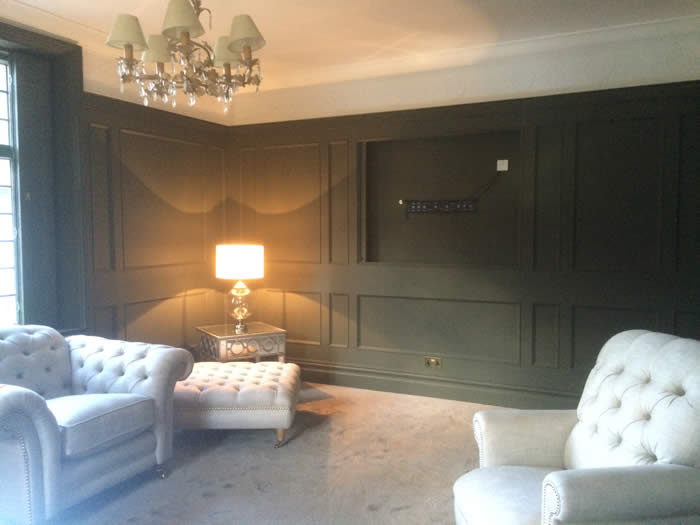Living room panelling ideas, a design concept that has stood the test of time, offers a plethora of possibilities to transform your living space into a haven of comfort, elegance, and timeless appeal. Delve into this comprehensive guide as we explore the latest trends, material options, installation techniques, and decorative accents that will empower you to create a living room that reflects your unique style and personality.
Design Ideas
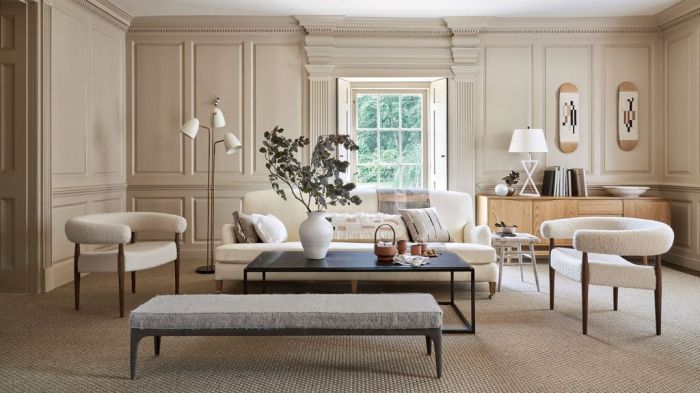
In the realm of interior design, living room paneling has emerged as a versatile and stylish way to transform walls into captivating focal points. The latest trends in paneling designs encompass a diverse range of styles, from traditional to modern and contemporary.
Traditional paneling often evokes a sense of timeless elegance. Wainscoting, a classic example, features a combination of vertical and horizontal panels that extend partially up the wall, creating a sophisticated and understated look. Modern paneling, on the other hand, embraces clean lines and geometric shapes.
It may incorporate materials such as metal or glass to achieve a sleek and contemporary aesthetic.
Contemporary paneling strikes a balance between tradition and modernity. It often features intricate patterns or textures, adding visual interest and depth to the walls. This style allows for customization and can be tailored to suit individual tastes and decor preferences.
Lighting plays a crucial role in enhancing the overall look of paneled walls. Natural light can accentuate the textures and patterns, creating a warm and inviting ambiance. Artificial lighting, such as wall-mounted sconces or recessed spotlights, can highlight specific panels or create dramatic shadows, adding depth and dimension to the space.
Impact of Lighting
- Natural light: Enhances textures and patterns, creating a warm and inviting atmosphere.
- Artificial lighting (wall-mounted sconces): Highlights specific panels, adding depth and dimension.
- Artificial lighting (recessed spotlights): Creates dramatic shadows, accentuating the contours of the panels.
Material Options
Choosing the right paneling material depends on your budget, style, and desired durability. Here’s a rundown of the most popular options:
Wood
Advantages
Natural beauty, warmth, durability, can be painted or stained to match any decor.
Disadvantages
Expensive, requires regular maintenance, susceptible to moisture and insects.
MDF (Medium-Density Fiberboard)
Advantages
Affordable, easy to install, smooth surface, paintable.
Disadvantages
Not as durable as wood, can be damaged by moisture.
PVC (Polyvinyl Chloride)
Advantages
Waterproof, fire-resistant, low maintenance, available in a wide range of colors and finishes.
Disadvantages
Can be more expensive than MDF, not as environmentally friendly.
Environmental Impact, Living room panelling ideas
Wood
Sustainable if sourced from responsibly managed forests.
MDF
Made from recycled wood fibers, but the manufacturing process can release harmful chemicals.
PVC
Non-biodegradable, can release toxic fumes when burned.
Color and Texture
The choice of color and texture for living room paneling can significantly impact the ambiance and visual appeal of the space. Understanding the psychological effects of colors and textures can help you create a living room that evokes the desired emotions and reflects your personal style.
Color Palette
The color palette you choose for your living room paneling should complement the overall style of the room. Warm colors, such as red, orange, and yellow, are known to create a cozy and inviting atmosphere. Cool colors, such as blue, green, and purple, have a calming and refreshing effect.
- Traditional styles:Rich, warm colors like burgundy, navy, and emerald green create a sophisticated and elegant look.
- Modern styles:Neutral colors like white, gray, and black provide a clean and contemporary backdrop for bold furniture and accessories.
- Bohemian styles:Earthy tones like beige, brown, and terracotta evoke a sense of warmth and coziness.
- Scandinavian styles:Light colors like white, beige, and pale gray create a bright and airy atmosphere.
Patterns and Textures
In addition to color, patterns and textures can add visual interest to living room paneling. Vertical panels can make the room feel taller, while horizontal panels can make it feel wider. Raised panels add depth and dimension, while flat panels create a more streamlined look.
- Wood paneling:The natural grain and texture of wood can add warmth and character to a living room.
- Fabric paneling:Upholstered panels can provide a soft and luxurious touch to the room.
- Stone paneling:Stone panels can add a touch of elegance and sophistication to a living room.
- Metal paneling:Metal panels can create a modern and industrial look.
Installation Techniques: Living Room Panelling Ideas
Before you begin, ensure you have the necessary tools and materials. These include a measuring tape, level, circular saw, hammer, nails, and wood filler.
Step 1: Measure and Cut the PanelsMeasure the wall where you want to install the paneling. Cut the panels to the desired length using a circular saw.
Step 2: Install the Furring StripsAttach furring strips to the wall horizontally, spaced 16 inches apart. These strips will provide support for the paneling.
Step 3: Install the Bottom PlateNail the bottom plate to the furring strips. This plate will serve as the base for the paneling.
Step 4: Install the PanelsStarting from the bottom, slide the panels into place. Use nails to secure them to the furring strips.
Step 5: Fill the GapsUse wood filler to fill any gaps between the panels. Sand the filler smooth once it has dried.
Tips for Avoiding Common Mistakes* Make sure the wall is level before installing the furring strips.
- Use a level to ensure the panels are installed straight.
- Avoid nailing the panels too close to the edges.
- Fill all gaps with wood filler to prevent drafts.
Decorative Accents
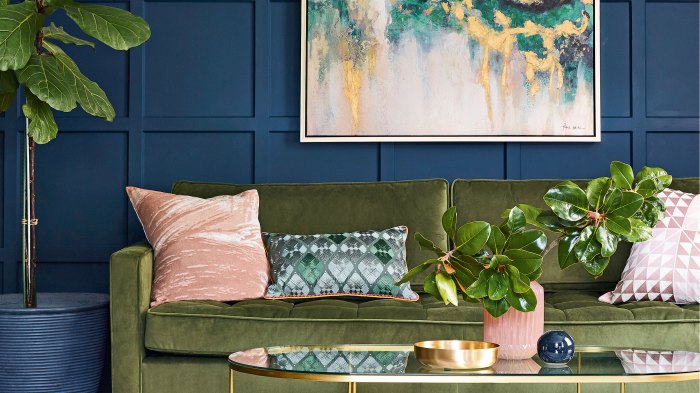
Elevate your paneled walls with decorative accents that add depth and character. From moldings and trims to wall art and lighting, explore creative ways to enhance the visual appeal of your space.
Moldings and Trims
- Add intricate moldings around the edges of panels to create a sophisticated and traditional look.
- Use chair rails to define the lower portion of walls, adding a touch of elegance.
- Incorporate baseboards and crown moldings to complete the overall design and add a sense of height.
Wall Art
Display artwork that complements the style of your paneling. Consider:
- Abstract paintings that add a modern touch.
- Landscapes that bring the outdoors in.
- Mirrors that reflect light and create the illusion of space.
Lighting
Use lighting to accentuate the textures and details of your paneling.
- Install recessed lighting to provide even illumination.
- Add sconces or pendant lights to create focal points.
- Use LED strip lights to highlight architectural features.
Plants and Accessories
Incorporate plants and accessories to bring life and warmth to your paneled space.
- Hang plants from the ceiling or place them on shelves.
- Display vases, sculptures, or other decorative objects on tables or mantels.
- Use throws and pillows to add color and texture.
Maintenance and Care
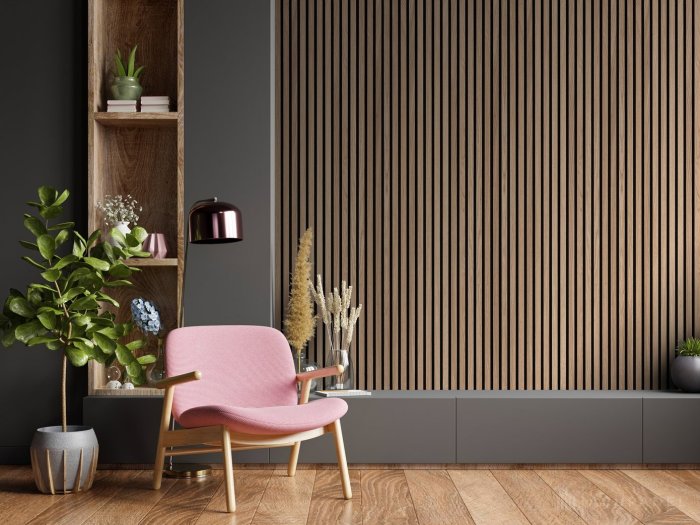
Maintaining living room paneling is crucial to preserve its aesthetic appeal and longevity. Different materials require specific care routines, so it’s essential to understand the appropriate methods for each type.
Regular cleaning removes dust, dirt, and smudges. Use a soft, damp cloth to wipe down the panels gently. Avoid harsh chemicals or abrasive cleaners, as these can damage the finish.
Cleaning Frequency and Methods
- Wood Paneling:Clean monthly with a damp cloth and wood cleaner specifically designed for wood surfaces.
- Laminate Paneling:Wipe down weekly with a damp cloth and a mild detergent solution.
- PVC Paneling:Clean monthly with a damp cloth and a vinyl cleaner. Avoid using harsh chemicals or abrasive cleaners.
Repairing Minor Damage
Minor scratches or dents can be repaired using touch-up kits specifically designed for the paneling material. Follow the manufacturer’s instructions carefully to ensure a seamless repair.
Cost Considerations
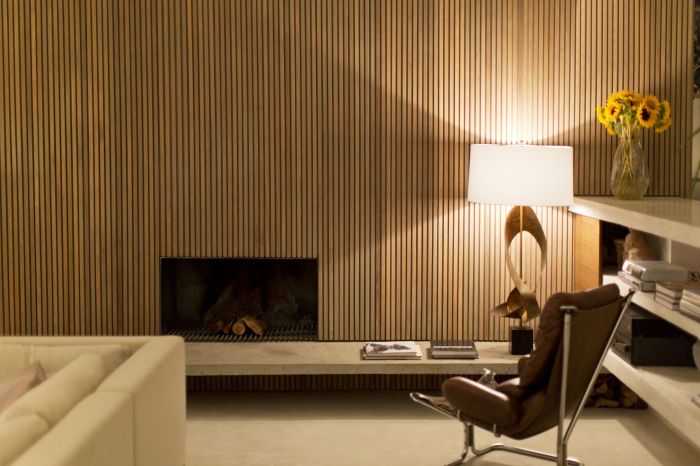
Paneling your living room can significantly enhance its aesthetic appeal, but it’s essential to consider the financial implications before embarking on this project. The overall cost will vary depending on several factors, including the materials used, installation method, and decorative accents.
Material Options
The cost of paneling materials can vary widely. Here’s a general overview:
- Wood
Natural wood paneling is a premium option, ranging from $5 to $20 per square foot.
- Engineered wood
A more affordable alternative to solid wood, engineered wood typically costs $2 to $10 per square foot.
- PVC
PVC panels are moisture-resistant and budget-friendly, with prices ranging from $1 to $5 per square foot.
- MDF
Medium-density fiberboard (MDF) is a versatile and cost-effective option, priced between $1 and $3 per square foot.
Installation Techniques
Installation methods also impact the overall cost:
- DIY installation
If you’re handy and have some carpentry skills, you can save money by installing the panels yourself. However, hiring a professional is recommended for more complex installations.
- Professional installation
Professional installation typically costs between $5 and $15 per square foot, ensuring proper alignment and a flawless finish.
Decorative Accents
Decorative accents can enhance the visual appeal of your paneling, but they come at an additional cost:
- Moldings
Crown molding, baseboards, and chair rails can add character and sophistication to your paneling, but they can also increase the cost by $1 to $5 per linear foot.
- Hardware
Decorative hardware, such as knobs and handles, can enhance the functionality and style of your paneling, but expect to pay $5 to $20 per piece.
Tips for Saving Money
- Consider less expensive materials
PVC and MDF panels offer a budget-friendly alternative to natural wood.
- Install the panels yourself
If you’re comfortable with DIY projects, installing the panels yourself can save you labor costs.
- Shop around for materials
Compare prices from different suppliers to find the best deals on paneling and installation services.
- Negotiate with contractors
If you’re hiring a professional installer, don’t hesitate to negotiate the price.
- Use reclaimed materials
Reclaimed wood or paneling from old buildings can be a cost-effective and environmentally friendly option.
By carefully considering these cost factors and implementing these money-saving tips, you can achieve a stunning paneled living room without breaking the bank.
Before and After Examples
Living room paneling can dramatically transform the space, both aesthetically and functionally. Here are some before and after examples that showcase the impact of paneling:
Design Choices and Techniques
In this living room, dark wood paneling was installed on the accent wall behind the fireplace. The paneling adds depth and warmth to the space, creating a cozy and inviting ambiance. The paneling also helps to define the seating area and create a focal point in the room.
In another example, white paneling was used to create a more modern and airy look in a living room. The paneling was installed on all four walls, and it helps to reflect light and make the room feel larger. The paneling also provides a clean and crisp backdrop for the furniture and accessories.
Impact on Ambiance and Functionality
Paneling can have a significant impact on the overall ambiance and functionality of a living room. Dark wood paneling can create a cozy and intimate space, while white paneling can create a more modern and airy look. Paneling can also be used to define different areas of the living room, such as the seating area, dining area, or home office.
In addition to its aesthetic benefits, paneling can also provide some functional benefits. For example, paneling can help to insulate the room and reduce noise levels. It can also be used to hide unsightly wires or cords.
Case Studies
Delve into the world of living room paneling through captivating case studies. Witness firsthand the transformation of ordinary spaces into extraordinary havens.
Homeowner’s Perspective
“Our living room was dull and uninviting. After installing elegant wood panels, it became the heart of our home, exuding warmth and character.”
Sarah, a satisfied homeowner
Designer’s Insights
“Paneling adds depth and dimension to a room. By experimenting with different materials, colors, and patterns, we create spaces that are both visually stunning and functional.”
Emily, an experienced interior designer
Project Challenges
- Selecting the right material to complement the existing decor
- Ensuring a seamless installation to prevent gaps or imperfections
- Incorporating panels into an existing layout without compromising space or flow
Innovative Solutions
- Mixing and matching panel styles to create a unique and eclectic look
- Using hidden fasteners to achieve a clean and modern aesthetic
- Designing panels that double as functional storage or display units
Future Trends
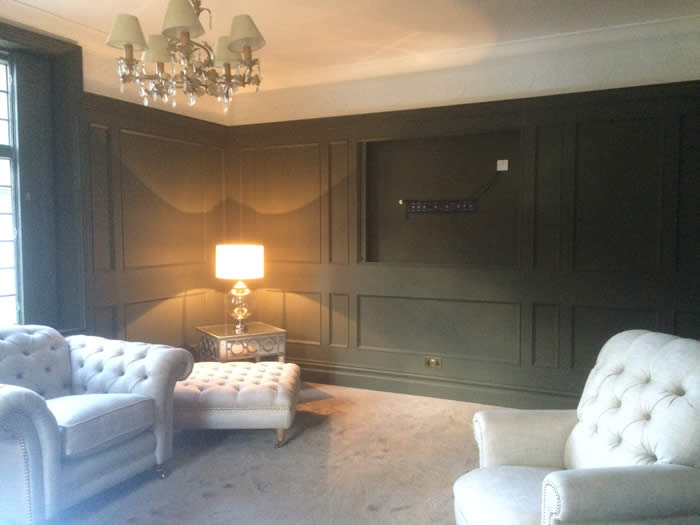
Living room paneling is evolving rapidly, driven by technological advancements and sustainability concerns.
Technology and Sustainability
Smart panels with integrated sensors and lighting are becoming increasingly popular. These panels allow for seamless control of lighting, temperature, and other home functions. Sustainable materials like bamboo and reclaimed wood are gaining traction as consumers seek eco-friendly options.
Innovative Materials
D panels create stunning visual effects with depth and texture. Self-adhesive panels offer easy installation, while magnetic panels allow for effortless reconfiguration of wall designs.
Personalized Designs
Customization is key in future paneling trends. Digital printing techniques enable homeowners to create unique designs that reflect their personal style.
Final Thoughts
As you embark on this journey of transforming your living room with panelling, remember that it’s not just about aesthetics but also about creating a space that resonates with your soul. Experiment with different design ideas, embrace the beauty of various materials, and let your creativity soar.
With careful planning and attention to detail, you can turn your living room into a sanctuary that exudes warmth, character, and enduring style.
FAQ Resource
What are the advantages of using wood for living room panelling?
Wood offers warmth, durability, and a timeless aesthetic appeal. It can be stained or painted to match any décor and adds a touch of natural elegance to the space.
How can I incorporate decorative accents into my panelled living room?
Consider adding moldings, trims, or wall art to enhance the visual appeal of your panelled walls. Lighting fixtures can also be used to create dramatic effects and highlight architectural features.
What are the latest trends in living room panelling design?
Contemporary designs often feature clean lines, geometric patterns, and a mix of materials. Natural wood tones and textured finishes are also gaining popularity, creating a warm and inviting atmosphere.
